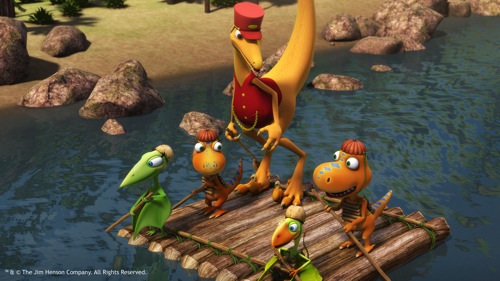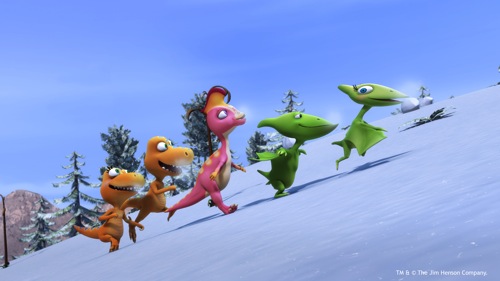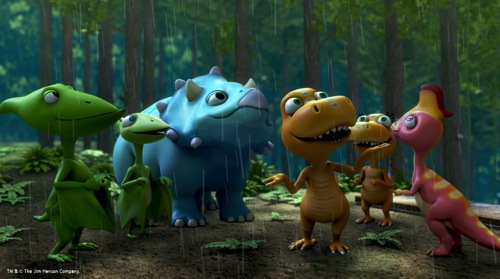Looking for something to watch today while the kids are home? PBS Kids is premiering a one hour special today called, Dinosaur Train: Nature Trackers Adventure Camp. The Pteranodon family are taking the kids and parents on a journey that features four stories that highlight nature and adventures in varying geographic locations. On their adventures, they zipline, raft and mountain climb, among other fun things.

As lovers of the outdoors, Nature Trackers Adventure Camp has us excited for our own outdoor excursions when the weather thaws a bit. I especially love how this episode has an interesting educational angle that engages my adventurers one step further. Click through to read more about this fun special!
“Nature Trackers Adventure Camp: Rafting”
Buddy, Tiny, Shiny and Don go river rafting for the first time at Nature Tracker Adventure Camp. Their old pal Jess Hesperornis meets up with them, and they all learn about erosion and the importance of rivers before finishing up their adventure by cruising through some rapids!
Educational Objective: Rivers and streams are ribbons of water that start at a high point and flow downhill – often with streams gathering into rivers. Animals and plants living on land depend on rivers and streams to provide fresh water and nutrients.
“Nature Trackers Adventure Camp: Mountain Climbing”
For their second outing at Nature Trackers Adventure Camp, Buddy, Tiny, Shiny, Don and other friends learn about the tree line as they set out to hike up a mountain. Shiny is determined to get to the top of mountain forest. Buddy wonders if they’ll be able to see anything from the mountaintop, through the tall trees. The kids are amazed that the higher they hike, the shorter the trees and bushes become! Then they reach the tree line – a certain point on the mountain where trees are really small because they don’t have enough air to breathe and the temperature is too cold. In the end, Shiny and all the kids use teamwork to all reach the mountaintop together!

Educational Objective: The timberline, or tree line, is a certain elevation on a mountain where the temperatures are colder, the air is thin and the soil is less moist, making it hard for most plants and trees to grow. Trees may grow as small shrubs. There is less oxygen, so it’s harder for animals to breathe at the tree line and above.
“Nature Trackers Adventure Camp: Ziplining”
The Nature Trackers Adventure Campers are back for another adventure – and this time they’ll be travelling to a rainforest! Once they arrive in the dense rainforest, the campers explore different levels of the ecosystem, including the forest floor and the canopy of leaves at the top of the forest. After a hike through the rainforest, the campers’ adventure culminates as each kid takes a ride on a zipline, where they all get a bird’s eye view of the entire rainforest!
Educational Objective: Rainforests are very dense, warm, wet, forests that are home to a vast array of different life forms. Rainforests get a lot of rain, at least 70 inches per year. Rainforests, often called the “lungs of the Earth,” generate much of the oxygen we breathe.
“Nature Trackers Adventure Camp: Canyon Hiking”
The Nature Trackers Adventure Campers are led by Mr. Conductor and Gilbert on a hike down a canyon, where they can see the different layers of the Mesozoic Era! At first, Lily Lambeosaurus is reluctant to go, thinking that a new adventure sounds hard, but Don convinces her that a new adventure can be worth the effort. At the bottom of the canyon, the kids dig for fossils. Each Nature Tracker goes home with a “new” Ammonite fossil, and Lily is so glad she tried something new!

Educational Objective: Canyons are deep cuts in the earth’s surface. They are formed by erosion. Erosion is mainly caused by the flow of rivers. It takes millions of years for canyons to become the grandiose natural landmarks they are today. The bottom rocks in canyons can date back billions of years, beyond the Mesozoic. Canyons can also be formed by a shift of the earth’s tectonic plates.

